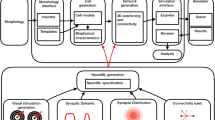Abstract
This article shows how the architectural modelization of biological retina allows real-time performances, on standard widespread computing systems. First, we describe the biological retina with regard to its pipeline architecture, detailing its layer behaviours and properties. Then we propose a corresponding pipelined model of artificial retina based on cellular automata. In this work, the main innovation is the computing method based on the programming of a personal computer graphical card using OpenGL shading language. The last section demonstrates the efficiency of our model through numerical and graphical results. We lay particular emphasis on the fact that our direct implementation of the Graphical Processor Unit (GPU) provides computation power about 20 times as fast as conventional programming.
Similar content being viewed by others
References
Rosenfeld A. (1979). Picture Languages. Academic, New York
Devillard, F., Gobron, S., Grandidier, F., Heit, B.: Implémentation par automates cellulaires d’une modélisation architecturale de rétine biologique. In: READ’05. Institut National des Télécommunications, Evry, France (2005)
Bonnet, C.: Traité de psychologie cognitive 1. Dunod (in french) (1989)
Mead C. (1989). Analog VLSI and neural systems. Addison, New York
Marr D. (1982). Vision. Freeman, San Francisco
Dacey D.M. (1996). Circuitry for color coding in the primate retina. Proc. Natl. Acad. Sci. USA 93: 582–588
Shreiner D., Woo M., Neider J. and Davis T (2003). OpenGL Programming Guide v1. 4. Addison-Wesley Professional, New York
Vichniac G.Y. (1984). Simulating physics with cellular automata. Physica 10D: 96–116
Kobayashi H., Matsumoto T., Yagi T. and Kanaka K. (1995). Light-adaptive architectures for regularization vision chips. Proc. Neural Netw. 8(1): 87–101
Kolb, H.: The neural organization of the human retina. Principles and Practices of Clinical Electrophysiology of Vision pp. 25–52 Mosby Year Boook, St. Louis (1991)
Kolb H. (2003). How the retina works. Am. Sci. 91: 28–35
Wässle H. and Boycott B.B. (1991). Functional architecture of the mammalian retina. Physiol. Rev. 71(2): 447–480
Conway J.H. (1970). Game of life. Sci. Am. 223: 120–123
VanBuren, J.M.: The retinal ganglion cell layer. Springfield, Illinois edn. Charles C. Thomas (1963)
Tran, J., Jordan, D., Luebke, D.: New challenges for cellular automata simulation on the GPU. http://www.cs.virginia.edu (2003)
Deshmukh K.S. and Shinde G.N. (2005). An adaptive color image segmentation. Electr. Lett. Comput. Vis. Image Anal. 5: 12–23
MacNeil M.A. and Masland R.H. (1998). Extreme diversity among amacrine cells: implications for function. Neuron 20(5): 971–982
Harris, M.: Implementation of a cml boiling simulation using graphics hardware. In: CS. Dept, UNCCH, Tech. Report, vol. 02-016 (2003)
Mahowald M. (1994). Analog vlsi chip for stereocorrespondance. Proc. IEEE Inter. Circuits Syst 6: 347–350
Ahnelt P. and Kolb H. (1994). Horizontal cells and cone photoreceptors in human retina. Comput. Neurol. 343: 406–427
Chaudhuri, P.P., Chowdhury, R.D., Nandi, S., Chattopaghyay, S.: Additive Cellular Automata Theory and Applications. IEEE Computer Society Press and Wiley (1993)
Rost, R.J.: OpenGL Shading Language, 2nd edn. Addison-Wesley Professional, New York (2006)
Druon, S., Crosnier, A., Brigandat, L.: Efficient cellular automaton for 2D/3D free-form modelling. Journal of WSCG 11 (1, ISSN 1213-6972) (2003)
Gobron S. and Chiba N. (1999). 3D surface cellular automata and their applications. J. Vis. Comput. Animat. 10: 143–158
Gobron S. and Chiba N. (2001). Crack pattern simulation based on 3D surface cellular automata. Vis. Comput. 17(5): 287–309
Wolfram S. (2002). A New Kind of Science. Wolfram Media, Champaign
Bernard T.M., Guyen P.E., Devos F.J. and Zavidovique B.Y. (1993). A programmable VLSI retina for rough vision. Mach. Vis. Appl. 7(1): 4–11
Beaudot, W.H.A.: Le traitement neuronal de l’information dans la rétine des vertébrés - un creuset d’idées pour la vision artificielle. Ph.D. thesis, Institut National Polytechnique de Grenoble, pp. 228 (1994)
Yang X.L., Tornqvist K. and Dowling J.E. (1988). Modulation of cone horizontal cell activity in the teleost fish retina I. Effects of prolonged darkness and background illumination on light responsiveness.. J. Neurosci. 8(7): 2259–2268
Author information
Authors and Affiliations
Corresponding author
Rights and permissions
About this article
Cite this article
Gobron, S., Devillard, F. & Heit, B. Retina simulation using cellular automata and GPU programming. Machine Vision and Applications 18, 331–342 (2007). https://doi.org/10.1007/s00138-006-0065-8
Received:
Accepted:
Published:
Issue Date:
DOI: https://doi.org/10.1007/s00138-006-0065-8




